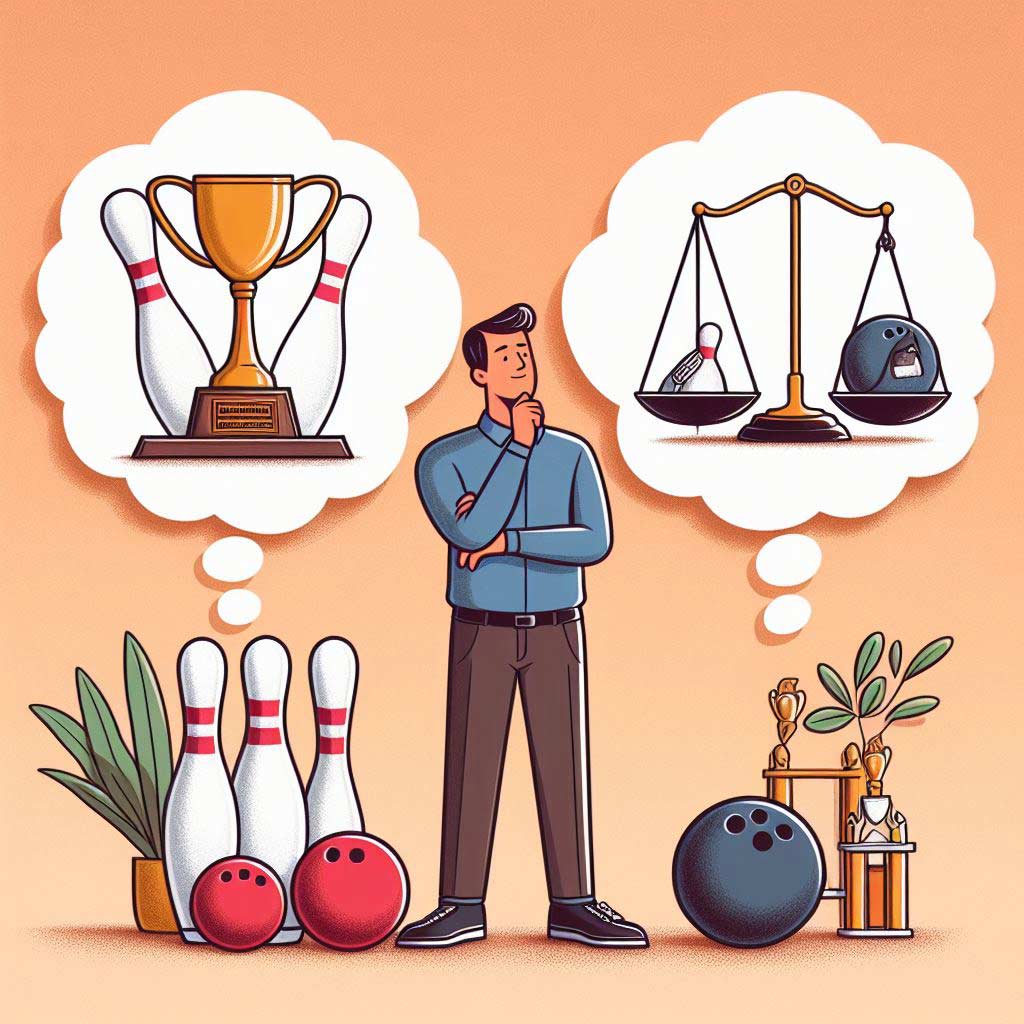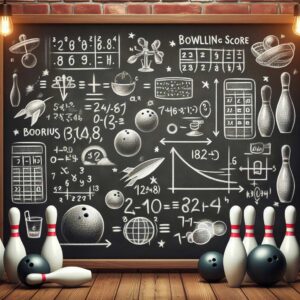Bowling is one of America’s most beloved pastimes, with over 70 million people heading to the lanes every year. Yet when it comes to handicaps, there are differing opinions on what constitutes a “good” or “bad” one.
For newcomers to the sport, a bowling handicap refers to the number of pins above the base score of 200 that you receive per game to compensate for lower skill levels. So a player with a 50 handicap would start with a score of 250.
But as your proficiency improves, your handicap decreases. A marginal bowler could have a handicap as high as 100 or more.
Meanwhile, 200 is considered “scratch” with no handicap. This enables players of all abilities to compete on a level playing field. However, having an especially high bowling handicap can be a double-edged sword.
In this in-depth guide, we’ll analyze the pros and cons of a lofty bowling handicap. You’ll discover the potential advantages and drawbacks, as well as tips for leveraging your high handicap to enhance your skills and enjoyment of the sport. Let’s weigh the key considerations from both perspectives.
The Potential Advantages of a High Bowling Handicap
First, let’s examine some of the benefits that come with a high bowling handicap for the beginning or struggling bowler:
Levels the Playing Field Against More Skilled Opponents
Without question, the primary purpose of a hefty handicap is to enable lower-average bowlers to compete evenly against far superior counterparts.
No one likes a blowout. So whether you are a 120 average player challenging a 180 average player, or a 100 versus 200, the handicap system aims to even the odds and make the matchup competitive.
Rather than get discouraged playing straight up, a handicap gives you a fighting chance. If you have a 100 bowling average, facing a 200-average bowler straight up could be demoralizing.
But with a 100-pin handicap, you start tied and have a chance to win. This helps bolster confidence and motivation to improve.
Allows You to Win Awards and Recognition
In many leagues and tournaments, prizes and awards are based on total pins with handicaps rather than raw scratch scores.
This allows fledgling bowlers to earn accolades they likely would not merit based on talent alone at this stage.
For instance, you may have the high handicap game or series for the week in your league, or place in your tournament division.
Such recognition can incentivize bowlers to stick with the sport during the steep learning curve when the average is under 150.
You are rewarded for your potential even if your actual scores are low. Handicapping lets the entire spectrum of bowlers feel like winners on any given night.
Reflects Your Best Potential on a Good Day
A bowler’s handicap is derived not from their average, but their highest average across multiple leagues and periods.
This means your handicap offers a glimpse of what you are capable of achieving on your A game. If you have bowled 180 before across enough games to establish it as your peak, your handicap reflects that potential.
So you may average 130, but your 180 high average earned you a 50-pin handicap. This allows you to post scores closer to your best performances rather than your typical middling ones. Handicapping takes your overall inconsistency and ups and downs into account.
Can Help Diagnose Specific Areas for Improvement
While some view handicaps as a crutch that can conceal underlying deficiencies, you can also use them strategically to diagnose where your game needs sharpening.
Break down your handicapped scores by category – how much comes from strikes versus spares? Where is your bonus pin cushion coming from? This helps expose weaknesses.
For instance, if you notice your spare shooting is worth 50 pins of the 100-pin total handicap, you know converting more single-pin spares is a priority. It gives a clearer window into your specific skill gaps beyond just the total score.
The Potential Drawbacks of a High Bowling Handicap
Of course, not everyone looks favorably on lofty handicaps. For the serious competitive bowler, it can suggest a lack of raw bowling talent and skill development. Here are some of the potential negatives associated with a high handicap:
Perceived as Not Reflecting “Real” Skill
In the eyes of bowling traditionalists and purists, an astronomic handicap is a sign of an unaccomplished bowler lacking fundamental ability.
Essentially, they believe you should not need almost 100 bonus pins per game to be competitive. This perception is that your scores are inflated more by the handicap than your merit.
You are not being judged on the ability the game was intended to test – knocking down pins.
Some old-school bowlers look down on those overly dependent on handicaps to save face or feel like winners. It is not considered “real” bowling success in their view without proving yourself scratch.
Less Chance to Win Scratch Tournaments or Prizes
Most local or regional tournaments offer separate handicapped and scratch divisions. Those with higher handicaps stand little chance of winning prizes or accolades in the scratch categories.
Your hefty handicap that boosts scores in league play won’t translate when competing against straight-up talent.
Even in handicapped events, the top prizes like the lowest net score frequently come down to those with the lowest full averages.
The marginal bowler with a major handicap is essentially eliminated from winning certain events where handicaps either don’t apply or are minimized.
Masks Flaws Needing Technical Correction
Another pitfall of an excessively high handicap is that it can sometimes cover up underlying technical deficiencies in your game.
If you are adding 100 pins through handicapping, major inefficiencies can be hidden. You may assume it is just about hitting spares or throwing more strikes. However, issues like poor timing, release, or targeting might require coaching.
Since your scores appear passable with a huge handicap, it delays identifying and correcting real physical or mental flaws.
You may plateau earlier than if forced to confront these hurdles sooner when handicaps were lower or non-existent.
Won’t Transfer Well to Scratch Formats
Most recreational bowlers enjoy no-tap leagues or events from time to time where 9 or 10 pins knocked down count as a strike.
This more relaxed format is for fun and levity. But it is based on scratch scoring with no handicapping or bonus pins. Bowlers dependent on 50+ handicaps will struggle mightily.
This reveals the lack of foundational skills and overly inflated averages that handicaps provided. It is a stark transition to go from a 260 average with a handicap down to a 130 average on a no-tap night. Handicaps simply do not transfer to formats or environments requiring true scratch bowling adequacy.
Tips for Leveraging a High Bowling Handicap
Rather than view an astronomical handicap as a negative, you can utilize it to your benefit:
- Set Goals Based on Personal Progress Rather than Others – Do not get caught up comparing your raw scores versus others’ each night. Instead, track your stats relative to your past performances. Are you up 10 pins on your average versus a month ago? That’s real advancement.
- Focus Practice on Specific Weak Links – Use your handicap to diagnose holes in spare shooting, corner pin accuracy, single pin conversion rates, etc. Then tailor practice to sharpen those niche skills rather than the overall score.
- Take Advantage of Handicapped League and Tournament Options – Build confidence and have fun competing in leagues and tourneys that apply your handicap and allow you to contend. Avoid scratch formats for now.
- Get Coaching to Lower Your Handicap Over Time – Enlist a coach to fix form errors and ingrain solid bowling fundamentals. This teaches real skills rather than relying on bonus pins from handicapping.
- Monitor Your Gradually Declining Handicap as a Benchmark – As you improve through focused practice and coaching, you will see your handicap incrementally decrease over seasons. This is a true indicator of sharpening your bowling abilities.
The Takeaway – Bowling Should Above All Be Fun!
At the end of the day, casual bowlers need to realize handicapping systems were designed so anyone at any level could enjoy the sport competitively.
If you have a passion for bowling, do not let an imposing handicap discourage you. The key is to leverage it for motivation while continuously honing skills.
Remember, bowling first and foremost should be fun and social. Do not get hung up on what constitutes a “good” or “bad” handicap.
Focus instead on making gradual improvements, competing against yourself, and enjoying time with friends on the lanes. Your handicap is merely a number and does not define you as a bowler or person.
Set milestones, utilize coaching, practice smart, and track progress. Over time, your scores and handicaps will rise and fall as your competency improves.
But always make bowling an enjoyable, relaxing escape. With the right attitude, a high handicap can be used to your advantage on the journey toward bowling excellence.
Frequently Asked Questions
What does handicap in bowling mean?
A bowling handicap is the number of bonus pins above 200 that a bowler receives per game to help even out the score between opponents of varying skill levels. Handicaps allow players of different averages to compete on a relatively even playing field.
Can you have a negative handicap in bowling?
No, a negative handicap is not possible in bowling. The lowest handicap is 0, also known as scratch. Anyone with a 200 average or higher would have a 0 handicap.
How many games is a bowling handicap?
Handicaps are generally based on your highest average across numerous games in many leagues over a long timeframe. Your handicap aims to reflect your overall potential rather than just recent scores. Most handicaps are established based on 100+ games.
What does 75 handicap mean?
In bowling, a 75 handicap means that 75 pins are added to the bowler’s total score. So if their scratch score is 150, with a 75-pin handicap their total score would be 225. This allows them to better compete with bowlers who have higher raw skills and averages.
How do you determine your handicap in bowling?
Bowling handicaps are determined based on your highest average across numerous leagues and long time periods, reflecting your best potential. Typical formulas are:
Men: 80% of the difference between your average and 220 Mixed: 90% of the difference between your average and 210.
What does minus handicap mean?
In sports betting, a minus (-) handicap indicates the team must win by more than the stated handicap. If Team A has a -2 handicap, they need to win by 3+ points to cover the spread. A minus handicap gives a disadvantage, usually to the favored team.
What is negative bowling?
In cricket, negative bowling refers to a defensive and cautious bowling style where the objective is minimizing runs scored rather than actively getting batters out. The bowler avoids presenting scoring opportunities and hopes batters make mistakes.



![Read more about the article Top Women’s College Bowling Teams: Find Your Perfect Fit [2024 Rankings]](https://bowlingbuff.com/wp-content/uploads/2024/04/Collegiate-Bowling-Motion-An-Artistic-Rendering-300x300.jpg)

